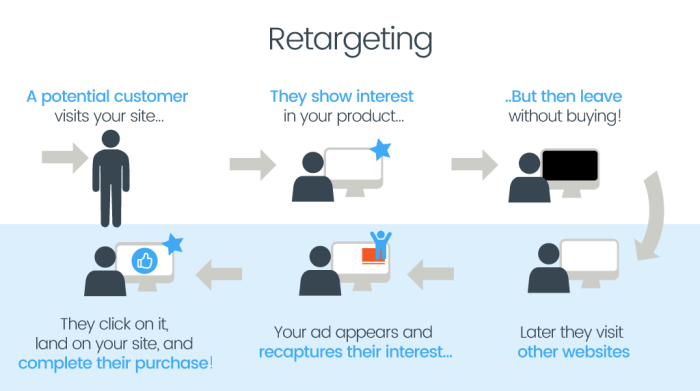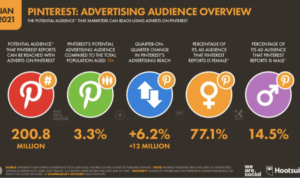As Retargeting Ads Guide takes center stage, this opening passage beckons readers with american high school hip style into a world crafted with good knowledge, ensuring a reading experience that is both absorbing and distinctly original.
Retargeting ads are like the cool kids of digital marketing, always popping up with relevant content just when you need it most. From understanding how they work to creating killer campaigns, this guide has got you covered.
Overview of Retargeting Ads

Retargeting ads, also known as remarketing ads, are a form of online advertising that targets users who have previously visited a website but did not complete a desired action, such as making a purchase. These ads follow users as they browse other websites or social media platforms, reminding them of the products or services they viewed earlier. By using cookies to track user behavior, retargeting ads aim to re-engage potential customers and encourage them to return to the site to complete a conversion.
Retargeting ads play a crucial role in digital marketing strategies by helping businesses increase conversions and drive sales. They enable businesses to reach out to users who have already shown interest in their products or services, making the advertising more targeted and personalized. This can lead to higher conversion rates and a better return on investment for the advertising budget.
Successful Retargeting Ad Campaigns
- Amazon: Amazon uses retargeting ads to remind users of products they viewed or added to their cart but did not purchase. This strategy has helped Amazon increase sales and improve customer retention.
- Netflix: Netflix uses retargeting ads to promote new shows or movies to users who have previously watched similar content on the platform. This personalized approach keeps users engaged and encourages them to continue using the service.
- Zappos: Zappos implements retargeting ads to showcase products that users have browsed on their website. By displaying these products on other websites, Zappos keeps their brand top of mind and encourages users to make a purchase.
Types of Retargeting Ads
Retargeting ads come in different forms to help businesses reconnect with potential customers who have shown interest in their products or services. Let’s explore the various types of retargeting ads below.
Pixel-Based vs. List-Based Retargeting
Pixel-based retargeting involves placing a tracking pixel on your website, which tracks the behavior of visitors and enables you to show them targeted ads based on their interactions. On the other hand, list-based retargeting uses email addresses or phone numbers provided by customers to create custom audiences for retargeting campaigns.
Dynamic Retargeting and Its Benefits
Dynamic retargeting takes personalization to the next level by displaying specific products or services that potential customers have viewed on your website. This tailored approach increases the chances of conversion by showing relevant ads to users based on their browsing history, leading to higher engagement and ROI.
Social Media Platforms in Retargeting Ads
Social media platforms play a crucial role in retargeting ads, as they allow businesses to reach a wider audience and engage with users on platforms like Facebook, Instagram, Twitter, and LinkedIn. By leveraging the data collected from these platforms, businesses can create targeted ads that resonate with users, increasing brand awareness and driving conversions.
Setting Up Retargeting Campaigns

To set up retargeting campaigns effectively, you need to follow a few key steps that will help you reach your target audience and maximize your results.
Creating Retargeting Ads on Popular Platforms
When creating retargeting ads on popular advertising platforms like Google Ads or Facebook Ads, follow these steps:
- Set up a retargeting pixel on your website to track visitors.
- Create custom audiences based on specific actions or pages visited.
- Design compelling ad creatives that resonate with your target audience.
- Set a budget and bidding strategy to optimize ad delivery.
- Monitor ad performance and make adjustments based on data insights.
Tips for Optimizing Retargeting Ad Campaigns
To optimize your retargeting ad campaigns for better results, consider the following tips:
- Rotate ad creatives regularly to prevent ad fatigue.
- Experiment with different ad formats and placements to find what works best.
- Use A/B testing to compare ad variations and identify top-performing ones.
- Optimize landing pages for a seamless user experience and better conversion rates.
- Implement frequency capping to avoid overwhelming users with too many ads.
Best Practices for Audience Segmentation
Segmenting your audience is crucial for a successful retargeting campaign. Follow these best practices for setting up audience segmentation:
- Segment audiences based on behavior, such as cart abandoners or repeat visitors.
- Utilize dynamic product ads to show personalized recommendations based on user interactions.
- Exclude converters from retargeting campaigns to avoid wasting ad spend on customers who have already made a purchase.
- Create lookalike audiences to reach new users who share similar characteristics with your existing customers.
Retargeting Ad Content
When it comes to retargeting ad campaigns, the content you create plays a crucial role in capturing the attention of your audience and driving them to take action. Compelling ad copy and visually appealing graphics can make a significant impact on the success of your retargeting efforts.
Importance of Compelling Ad Copy and Visuals
Creating engaging ad content is essential to re-engage users who have already shown interest in your products or services. By crafting persuasive copy and using eye-catching visuals, you can remind potential customers of what they were interested in and encourage them to make a purchase.
- Use clear and concise language that highlights the benefits of your products or services.
- Incorporate strong calls-to-action that prompt users to click on your ad.
- Utilize high-quality images or videos that are relevant to your target audience.
- Personalize your ad content based on the user’s previous interactions with your website.
Engaging Content Ideas for Retargeting Ads
Coming up with creative content ideas for retargeting ads can help you stand out from the competition and capture the attention of your audience. Here are some examples of engaging content ideas:
- Offer exclusive discounts or promotions to entice users to complete their purchase.
- Showcase customer reviews or testimonials to build trust and credibility with potential customers.
- Create dynamic product ads that display items users have viewed on your website.
- Use interactive elements, such as quizzes or surveys, to engage users and gather valuable data.
A/B Testing Strategies for Retargeting Ad Content, Retargeting Ads Guide
A/B testing is a powerful tool that can help you optimize your retargeting ad content for better performance. By testing different variations of your ads, you can identify which elements resonate best with your audience and drive the most conversions.
- Experiment with different ad copy, visuals, and calls-to-action to see which combinations result in the highest click-through rates.
- Test different audience segments to determine which groups are most responsive to your retargeting ads.
- Track key metrics, such as conversion rates and return on ad spend, to measure the effectiveness of your A/B tests.
- Use the insights gained from A/B testing to continually refine and improve your retargeting ad content for maximum impact.
Measuring Retargeting Ad Performance: Retargeting Ads Guide
In order to evaluate the success of retargeting ad campaigns, it is crucial to focus on key performance indicators (KPIs) that provide insights into the effectiveness of your strategies. By tracking these metrics, you can make data-driven decisions to optimize your retargeting efforts.
Key Performance Indicators (KPIs)
- Click-Through Rate (CTR): This metric measures the percentage of users who click on your retargeting ads after seeing them. A high CTR indicates that your ads are engaging and relevant to your audience.
- Conversion Rate: The conversion rate shows the percentage of users who complete a desired action, such as making a purchase or signing up for a newsletter, after clicking on your retargeting ads. It reflects the effectiveness of your ad in driving conversions.
- Return on Ad Spend (ROAS): ROAS calculates the revenue generated for every dollar spent on retargeting ads. It helps determine the profitability of your campaigns and allows you to allocate budget more efficiently.
- Cost Per Acquisition (CPA): CPA reveals the average cost of acquiring a customer through retargeting ads. By tracking this metric, you can assess the cost-effectiveness of your campaigns and optimize your targeting strategies.
Tools and Analytics Platforms
- Google Analytics: A popular tool for tracking website traffic, conversions, and user behavior. It provides valuable insights into the performance of your retargeting campaigns and helps you optimize your targeting based on user data.
- Facebook Pixel: An analytics tool that allows you to track user interactions with your Facebook ads and website. It provides valuable data for measuring the effectiveness of your retargeting efforts on the platform.
- AdRoll: A retargeting platform that offers robust analytics and reporting features to track the performance of your retargeting campaigns across multiple channels. It helps you optimize your strategies for better results.
Interpreting Data and Making Data-Driven Decisions
- Regularly review and analyze performance metrics to identify trends and patterns in user behavior. Use this data to refine your targeting strategies and ad content for better engagement.
- A/B testing different ad creatives, messaging, and targeting options to determine what resonates best with your audience. Implement changes based on the results to improve campaign performance.
- Segment your audience based on behavior, demographics, or interests to tailor your retargeting ads for specific groups. Personalizing your messaging can lead to higher engagement and conversions.





